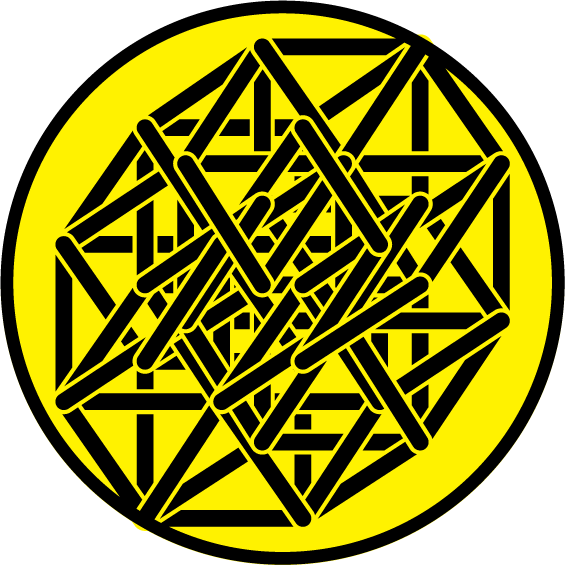Infinity with Max Cooper — In Six Minutes
One, two, three, infinity.
—George Gamow
contents
- 1 · Oh my God, it's full of numbers
- 2 · One, two, three, infinity
- 3 · Glitches in the story
- 4 · Hilbert's Grand Hotel
- 5 · New bijections await
- 6 · Last stop before switching infinity trains
- 7 · Beyond infinity — other infinities
- 8 · Power set of natural numbers
- 9 · Cardinality of the continuum
- 10 · Aleph 2
The video starts straight at number 1 and go to infinity (and beyond). Let's go!
The walkthrough includes key mathematical details behind the theory of transfinite numbers. The story is aimed at a math-enthusiast audience. For even more details for the hardy and curious, I cover some advanced concepts in set theory, such as beth numbers and ordinal numbers.
This math may cause you to lose sleep. I hope it does, as many things in life are worth staying awake for.
Take care — I'm not a set theoretician. Please report errors, technical shortcomings and places where you feel the explanations are lacking.
The video begins humbly is with the first natural number, 1.
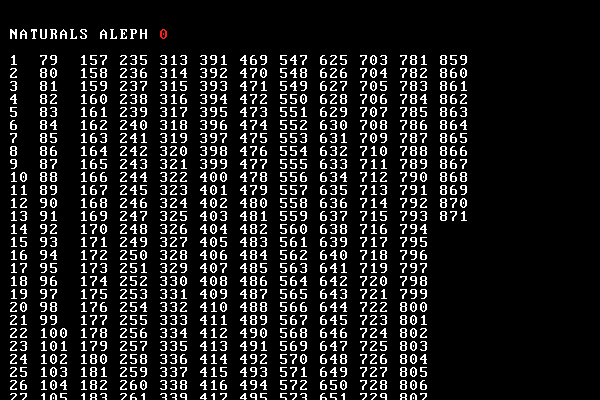
What follows are all the other natural numbers—everyone has their favourite. I like 17.
All the natural numbers make up a set, $\mathbb{N}$. $$\mathbb{N} = \{ 1, 2, 3...\}$$
We never run out of these numbers—to get the next one just take the previous and add one. This process of adding one to get the next number is called the successor function. For now, this is easy but we'll see below an application of this that's a little trickier.
How big is $\mathbb{N}$? In set theory, the size of a set is referred to as its cardinality and denoted by $|\mathbb{N}|$. At this point you might simply want to answer "It's infinitely large!" and be done with it.
Hang around, though. This is just where the story gets interesting.
To acknowledge the fact that your mind might glitch while investigating infinity, you'll see that the music video glitches as well.
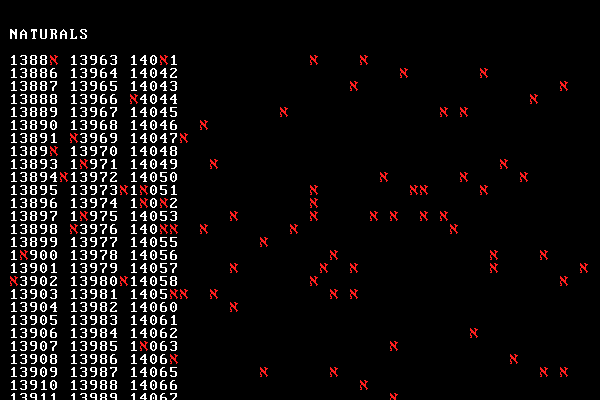
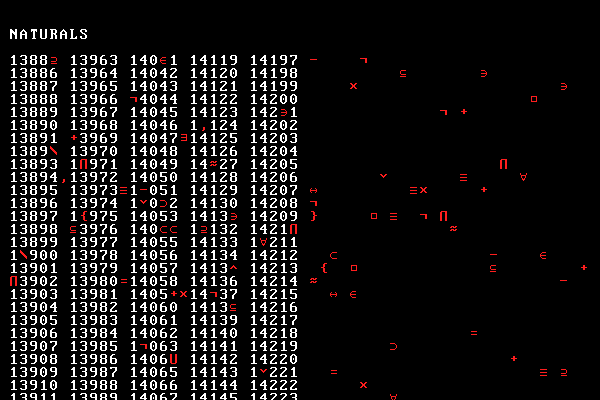
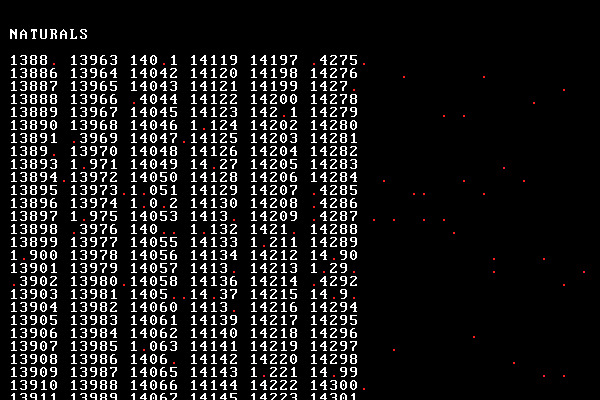
As the video progresses, the frequency and intensity of the glitching is increased and new set theory symbols are added. Many of the glitches are triggered by the snare drum. As the percussion becomes more intense, so does the glitching.
The video ends with a return to the counting of natural numbers which then glitches into a blank screen and only `\aleph` remains.
There is a magical place called the Grand Hotel. It has an infinite number of rooms, each indexed by a natural number.

Despite the fact that this hotel is always completely full, it can always accommodate another guest. To do this, we ask everyone to move to room $n+1$ thus freeing up room $1$. We have solved the problem at the cost of annoying infinitely many people.
But wait. There's infinitely more.
The hotel can always accommodate an additional infinite number of guests. Everyone is asked to move to room $2n$ thus freeing up all odd-numbered rooms. Since there's an infinite number of these rooms, we've just doubled the capacity!
I don't mean to suggest that I loved you the best
I can't keep track of each fallen robin
I remember you well in the Chelsea Hotel
That's all, I don't even think of you that often
— Leonard Cohen, Chelsea Hotel No. 2
The craziness is only beginning. If an infinite number of busses show up, each with an infinite number of guests, guess what? Yup, they can all be accommodated.
First, denote the $i$th guest in the $j$th bus by $s_n = (i,j)$. Since $i \in \mathbb{N}$ and $j \in \mathbb{N}$ then, we can enumerate $s_n$ as $s_1, s_2, s_3, ...$ Then, the formula for assigning guests to rooms is to assign guest $i$ from bus $j$ to room $n$. In this scheme, the hotel itself is treated as a bus indexed by $j = 0$.
This is sometimes called “Hilbert's Paradox” but it's not really a paradox. Rather, it's a demonstration that we should not expect intuition about finite quantities to carry over to the behaviour of infinite quantities.
Case in point, in Hilbert's hotel "there is a guest in every room" does not imply that "no more guests can be accommodated".
Your mind may be in revolt at this moment. “Surely, there are fewer even numbers than natural numbers, since even numbers are a proper subset of natural numbers!”
First, in a hotel with finite number of rooms, you would be correct.
Second, your confusion puts you in good company. Gregor Cantor (1845-1918), the mathematician who was the first to develop a theoretical framework of infinite quantities, suffered recurrent nervous breakdowns.
Remember the concept of the cardinality of a set? Cantor assigned the number $\aleph_0$ (named so after the first letter, aleph, in the Hebrew alphabet) to represent the cardinality of the naturals.
He called the family of numbers, in which $\aleph_0$ is the first, transfinite numbers . Today ‘infinite’ is more commonly used to refer to these numbers.
For two sets to have the same cardinality a special condition has to be met. We say that $|X| = |Y|$ if and only if we can demonstrate a function $f(X) \mapsto Y$ that is one-to-one, meaning that $f(x \in X)$ maps to a unique $y \in Y$, and onto, meaning that every $y \in Y$ is mapped to by some $x \in X$.
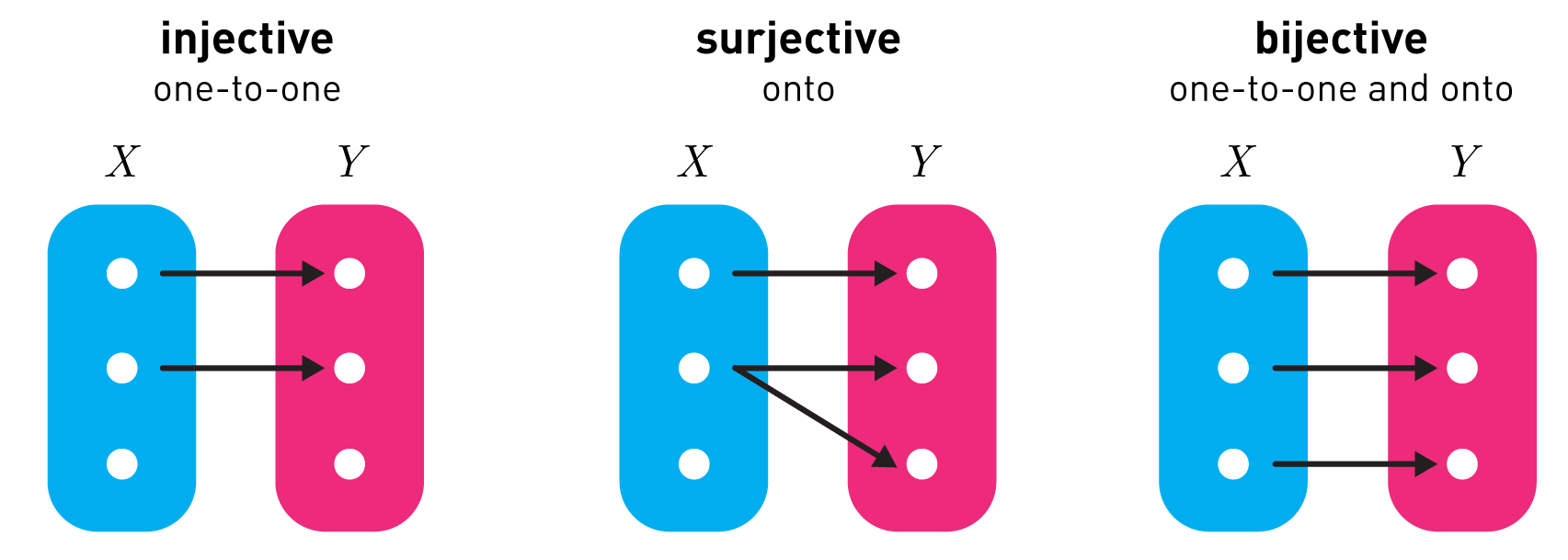
In other words, to show that two sets have the same cardinality, we just have to find a bijection. Here is one between the even numbers and natural numbers $$ f(\{2,4,6,8,...\} \mapsto \mathbb{N}) : x \mapsto x/2 $$
To show that $f$ is a bijection we need to show that $f$ is injective and surjective. It is injective (one-to-one) since any two distinct even numbers $x \ne y$ are sent to distinct values $x/2 \ne y/2$. It is surjective (onto) since every natural number $x$ has an even number $2x$ that is mapped to it.
There are lots of sets that have the same cardinality as the naturals: odd numbers, even numbers, prime numbers. Any infinite subset of naturals has the same cardinality as the naturals.
The next chapter in the video brings us to the observation that since the naturals are a subset of the integers, $\mathbb{Z}$ and since both are infinite, both have to have the same cardinality.
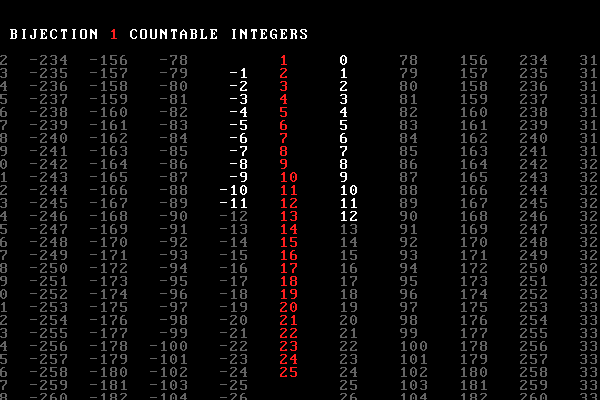
The video shows a bijection between the two sets, $f(\mathbb{N}) \mapsto \mathbb{Z}$ defined as follows: $f(0) \mapsto 0$ and $f(2k) \mapsto k$, $f(2k-1) \mapsto -k$ for $k \in \mathbb{N}$. Even naturals are sent to positive integers and odd naturals are sent to negative integers. Each natural has a unique integers (injective) and all integers are covered (surjective).
For example, the positive integer $n$ is mapped from $2n \in \mathbb{N}$ (e.g. $22 \mapsto 11$) and the negative integer $-n$ from $-(2n-1)$ (e.g. $23 \mapsto -11$).
The next part of the video shows many more possible bijections.
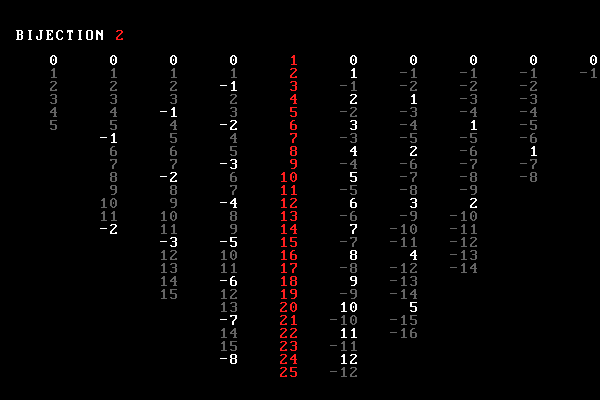
The first column on the right of the naturals is the bijection described above and others take the form $$f(x \in \mathbb{N}) = \begin{cases} 0, & \text{if $x = 1$} \\k, & \text{if $x$ is the $k$th number that passes the rule $g(x)$} \\-k, & \text{if $n$ is the $k$th number that fails the rule $g(x)$} \end{cases} $$
For our first bijection, the rule was $g(x) \stackrel{?}{=} 2k$, which checks whether $x$ is even.
The second column on the right of the naturals uses the rule $g(x) \stackrel{?}{=} 4k$, which checks whether $x$ is a multiple of 4. Thus, $4 \mapsto 1$, $8 \mapsto 2$, $12 \mapsto 3$ and so on. All naturals that are not multiples of 4 are sent to negative integers.
Columns on the left of the naturals use an odd multipler in the $g(x)$ rule and additionally flip the sign of the integer to which $f(x)$ maps. This was done so that I could have an equal balance of white positive integers in the columns on the right and white negative integers in the columns on the left.
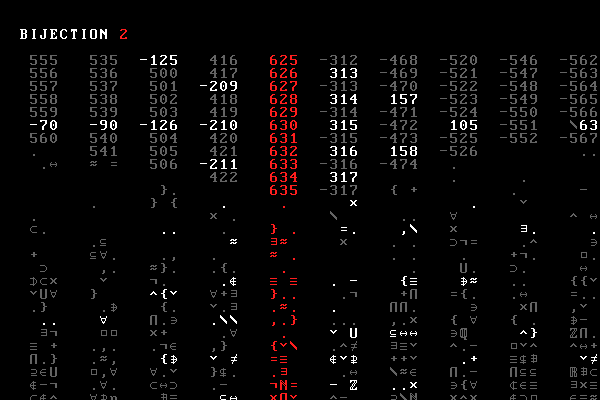
As we sample more natural numbers, pages of bijections update faster and faster, in waves of numbers that decay into symbols used in set theory.
Because I could not stop for Death —
He kindly stopped for me —
The Carriage held but just Ourselves —
And Immortality.
...
Since then — 'tis Centuries — and yet
Feels shorter than the Day
I first surmised the Horses' Heads
Were toward Eternity —
— Emily Dickinson
We ramp up the complexity in the video by showing a bijection between the natural numbers and rational numbers, $\mathbb{Q}$, which are all fractions of the form $\mathbb{Q} = \{ q = x/y, x,y \in \mathbb{N}_0, y \ne 0 \}$.
First, we create a table in which the cell in row $x$ and column $y$ is assigned the rational number $x/y$.
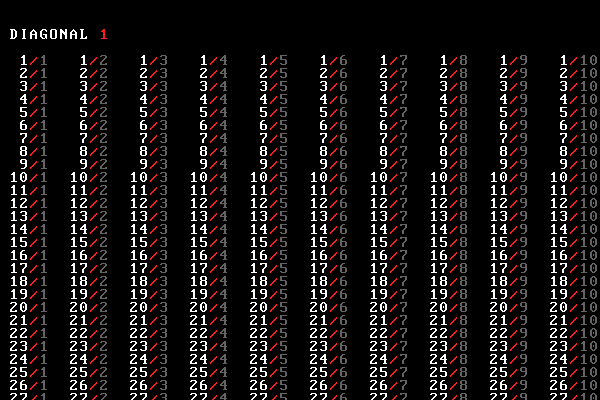
To create the bijection, we assign each rational to a natural number as we traverse the table in a zig-zag fashion.
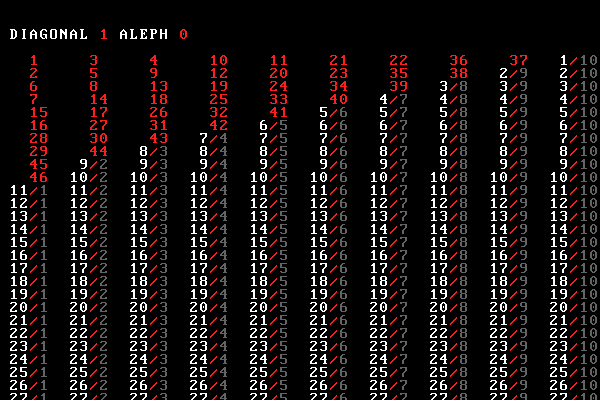
We snake our way from the upper-left corner ($1/1$) to the bottom-right ($78/31$), which is assigned 2418.
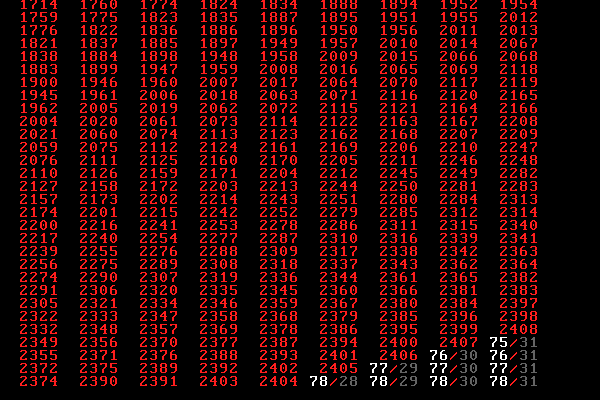
Given that rational numbers can be considered as two-dimensional naturals, $\mathbb{Q} = \mathbb{N}^2 = { \mathbb{N} \times \mathbb{N} }$, the same traversal argument can be used to show that all higher-dimensional spaces of naturals also have the same cardinality as the naturals, $|\mathbb{N}^k| = |\mathbb{N}|$. The bijection construction is the same as in the $k=2$ case above, except that now we're snaking across a higher dimensional space. When $k$ itself is infinite, we have the scenario of infinite guests in infinite busses arriving at Hilbert's Grand Hotel.
In our story so far, we have shown bijections between $\mathbb{N}$ and $\mathbb{Z}$ and $\mathbb{Q}$ we have proven that all these sets have the same cardinality $|\mathbb{N}| = |\mathbb{Z}| = |\mathbb{Q}| = \aleph_0$.
To summarize, the naturals are considered to be infinite but countable and any set that has a bijection with the naturals is also countable.
Our discussion has brought us to infinity, $\aleph_0$. What lies beyond?
The first hint that there is indeed something beyond lies in the proof that the real numbers, $\mathbb{R}$ are not countable: there is no bijection between the naturals and reals. If we try to pair up naturals and reals we'll always run out of naturals.
Real numbers are continuous quantities that, for example, can measure the distance along a line. They include the naturals, integers, rationals as well as irrationals, which include numbers like $\sqrt{2}$, which cannot be written as a fraction, and numbers like $\pi$, which are transcendentals and not solutions to polynomial equations.
Cantor's demonstration that $|\mathbb{R}| > |\mathbb{N}|$ is the next part of the story. The proof is by contradiction and applies to the unit interval $ [0,1) = \{ x \, | \, 0 \le x \lt 1 \}$. First, suppose that there is a bijection $f(\mathbb{N}) \mapsto [0,1)$. This implies that for each $n \in \mathbb{N}$ there is some associated $r \in [0,1)$. We write down this assignment—for each natural, we pair up a natural with a real from the unit interval. Obviously, this list goes on forever in both the vertical and horizontal direction.
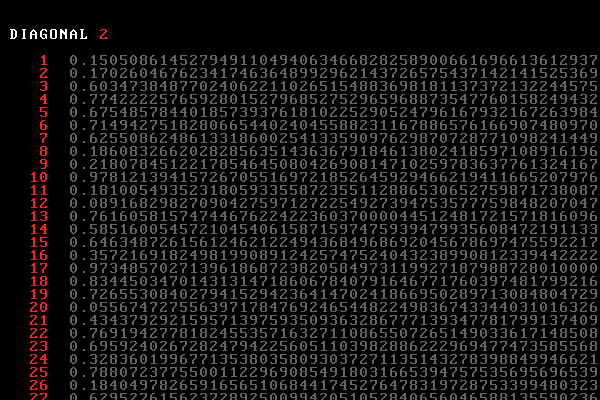
We don't know what the exact assignment is, so the numbers in the story are only representative. Typically, the proof is written out symbolically with each natural $n_i$ assigned to a series of digits $n_{i1}n_{i2}n_{i3} ... $.
Because this assignment is a bijection it is a surjection and every real number from the unit interval appears somewhere in the list. If we could demonstrate that there is a real number from $[0,1)$ that doesn't appear in the list, we would have a contradiction and the assumption that a bijection exists would be invalid.
We do so as follows. We transform the first digit of the first real to $x \mapsto x + 1 \, \text{mod} \, 10$. In other words $0 \mapsto 1$, $1 \mapsto 2$ and $9 \mapsto 0$.
We do the same for the second digit of the second number, the third digit of the third number, and so on.
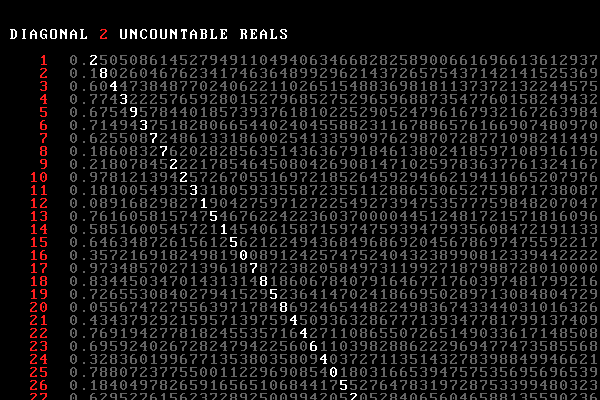
This creates a new real, shown here without the leading $0.$
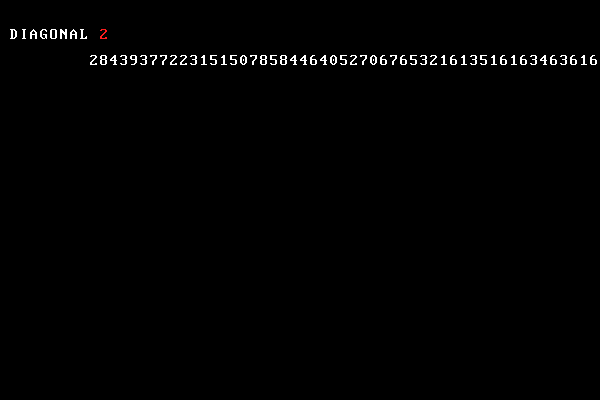
By construction, this real is nowhere in our list of reals. It can't be—it's different from each of the reals in at least one digit. It's different from the first number in the first digit, the second number in the second digit, the third number in the third digit and so on. But it's obviously in the unit interval. A contradiction.
If we write the numbers in the unit interval in binary $ [0,1) = \{ 0.b_1b_2b_3,... \, | \, b \in \{0,1\} \}$ we can use the fact that $b_i$ is indexed by $\mathbb{N}$ to realize that there are $2^{|\mathbb{N}|}$ such binary numbers, since at each position we have two choices ($0$ or $1$). And because $|\mathbb{N}| = \aleph_0$ we have $$ |\mathbb{R}| = 2^{|\mathbb{N}|} = 2^{\aleph_0} $$
Given a set $X$, the power set is the set of all subsets of $X$, including the empty set.
The next part of the story builds up the power set of naturals, $\mathbb{P}(\mathbb{N})$.
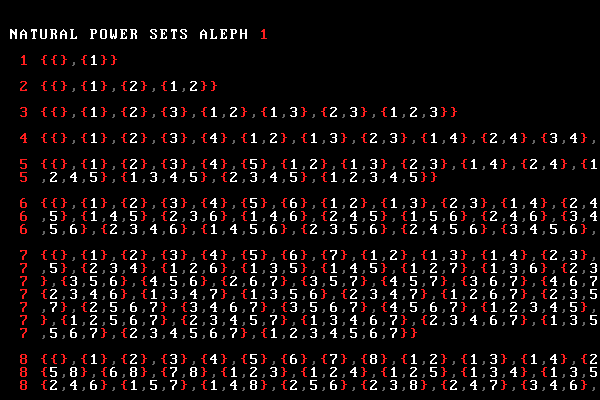
For example, for $X = \{1\}$ the power set has two elements, the empty set $\{\}$ and the whole set $\{1\}$. We write $ \mathbb{P}(X) = \{\{\},\{1\}\} $.
For $X = \{1,2\}$ the power set has four elements, the empty set $\{\}$, each of the naturals on their own $\{1\}$ and $\{2\}$ and the whole set $\{1,2\}$. We write $ \mathbb{P}(X) = \{\{\},\{1\},\{2\},\{1,2\}\} $.
In general, the power set of $\{1,2,3,...,n\}$ has cardinality $2^n$.
If we look closely at the $ 2^{\aleph_0} $, we can interpret it as the cardinality of the power set of naturals. This is because for each natural, of which there are $ \aleph_0 $ we have two choices: put it in the subset or not.
As the video continues, the power set elements appear faster and faster. The braces form hypnotising patterns.
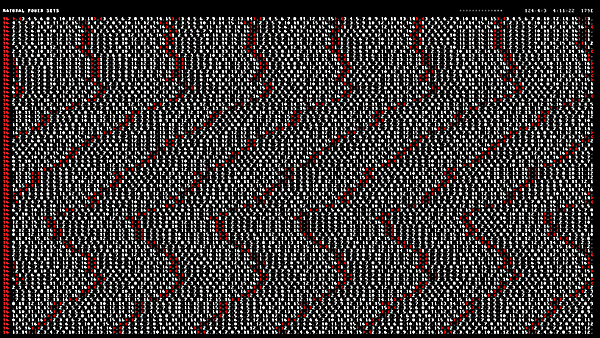
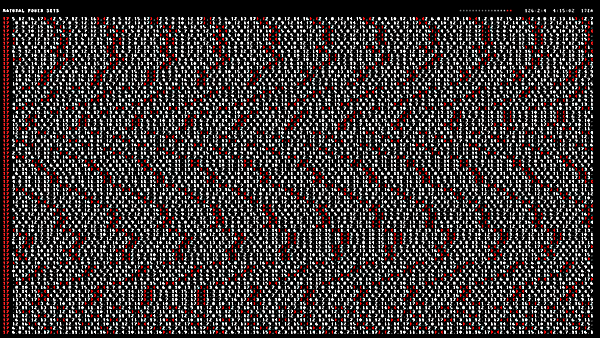
Because the reals are continuous quantities, the number of reals is (wonderfully) called the cardinality of the continuum. I wouldn't turn down the job of cardinal of the continuum.
Given what we learned about power sets of naturals above, we can write $$ |\mathbb{R}| = | \mathbb{P}(\mathbb{N}) | = 2^{\aleph_0} $$
With Cantor's diagonal proof, we know that $|\mathbb{R}| > \aleph_0$ but we don't know how much larger. Cantor therefore proposed the Continuum Hypothesis which stated that whatever the size of $2^{\aleph_0}$ was, it was a distinct kind of infinite number and, importantly, the next smallest infinite number after $\aleph_0$.
A consequence of this theorem is that there is no set $X$ for which $$ \aleph_0 \lt |X| \lt 2^{\aleph_0} $$
meaning that there is no set that is larger than the naturals but smaller than the reals.
The Continuum Hypothesis also implies that the cardinality of the continuum is the next number ($\aleph_1$) in the hierarchy of transfinite cardinals, $$ |\mathbb{R}| = 2^{\aleph_0} = \aleph_1 $$
From it, we also get that the cardinality of the power set of an infinite set is the next transfinite cardinal. In other words, for sets $\mathbb{N}, \mathbb{P}(\mathbb{N}), \mathbb{P}(\mathbb{P}(\mathbb{N})), ...$ the cardinalities are $\aleph_0, \aleph_1, \aleph_2, ...$ And in general, $$ \aleph_{\alpha+1} = 2^{\aleph_\alpha} $$
The Continuum Hypothesis is thus far unproven.
At this point, we arrive at the third infinity in the video—the cardinality of the power set of reals is $ | \mathbb{P}({\mathbb{R}}) | = \aleph_2 $.
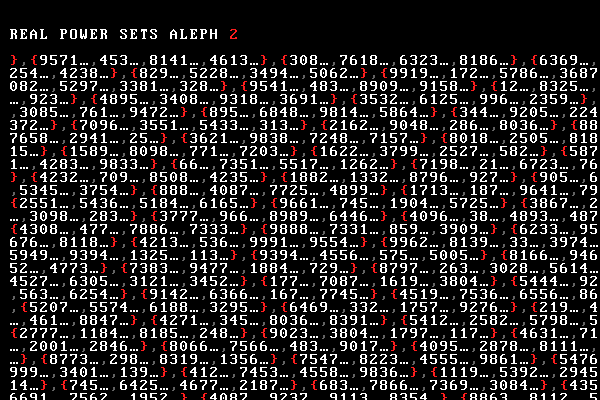
Elements of the power sets of naturals and reals continue to flash. If the Continuum Hypothesis is true, their cardinality is $\aleph_1$ and $\aleph_2$ respectively.
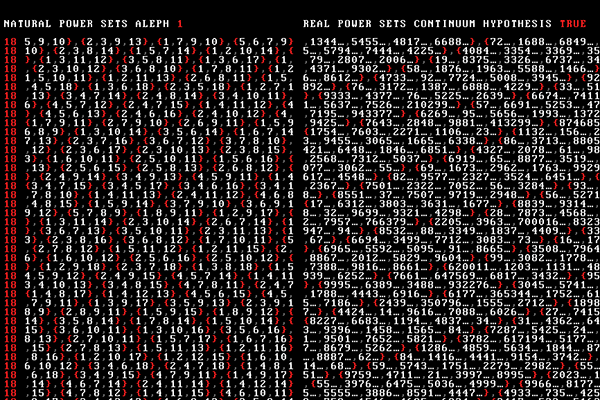
The music grows in intensity and the scene deteriorates into set theory symbols.
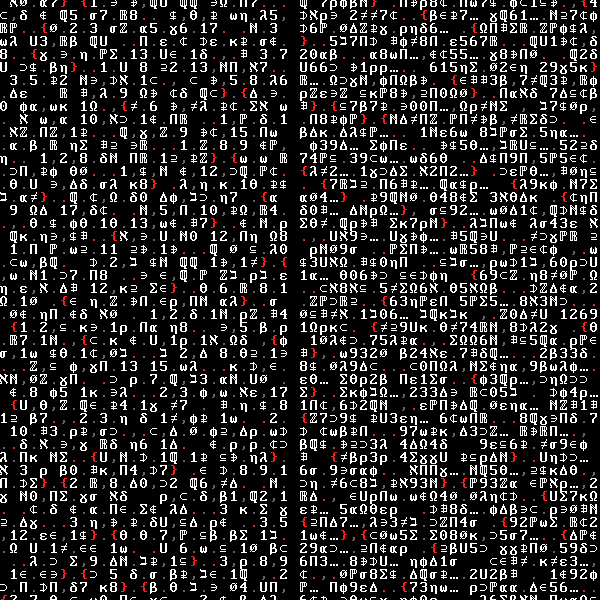
The story brings us back to where we started from: the list of naturals. These pick up where we left off and continue counting.
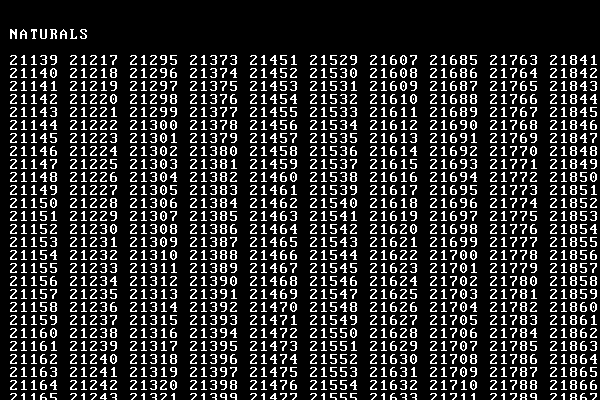
These too decay in a jitter of symbols
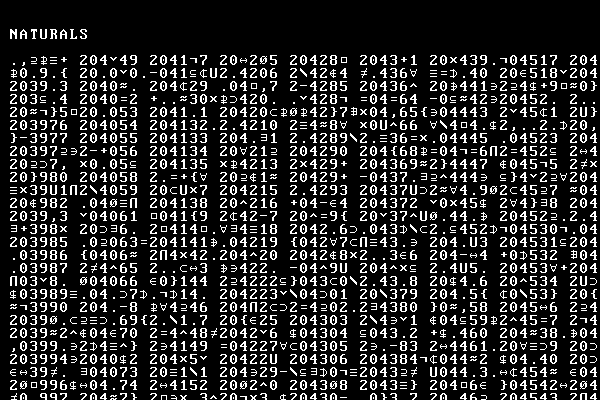
with soon nothing but symbols left
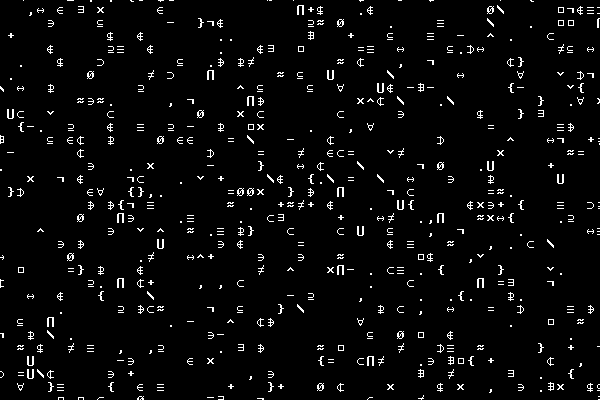
Suddently $\aleph$ appears.
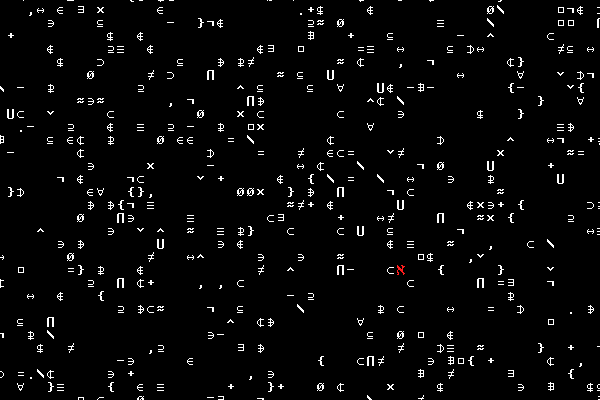
And while everything else decays,
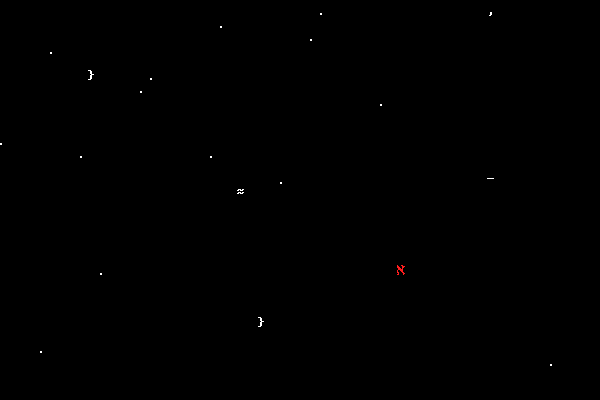

We are reminded of where we started, how far we've gone and how many more infinites are left to go.
How many ages hence
Shall this our lofty scene be acted over,
In states unborn and accents yet unknown!
— William Shakespeare
And so, in our yearning for the infinite, we return to basic counting and find that we never understood it well in the first place.
Beyond Belief Campaign BRCA Art
Fuelled by philanthropy, findings into the workings of BRCA1 and BRCA2 genes have led to groundbreaking research and lifesaving innovations to care for families facing cancer.
This set of 100 one-of-a-kind prints explore the structure of these genes. Each artwork is unique — if you put them all together, you get the full sequence of the BRCA1 and BRCA2 proteins.
Propensity score weighting
The needs of the many outweigh the needs of the few. —Mr. Spock (Star Trek II)
This month, we explore a related and powerful technique to address bias: propensity score weighting (PSW), which applies weights to each subject instead of matching (or discarding) them.

Kurz, C.F., Krzywinski, M. & Altman, N. (2025) Points of significance: Propensity score weighting. Nat. Methods 22:1–3.
Happy 2025 π Day—
TTCAGT: a sequence of digits
Celebrate π Day (March 14th) and sequence digits like its 1999. Let's call some peaks.

Crafting 10 Years of Statistics Explanations: Points of Significance
I don’t have good luck in the match points. —Rafael Nadal, Spanish tennis player
Points of Significance is an ongoing series of short articles about statistics in Nature Methods that started in 2013. Its aim is to provide clear explanations of essential concepts in statistics for a nonspecialist audience. The articles favor heuristic explanations and make extensive use of simulated examples and graphical explanations, while maintaining mathematical rigor.
Topics range from basic, but often misunderstood, such as uncertainty and P-values, to relatively advanced, but often neglected, such as the error-in-variables problem and the curse of dimensionality. More recent articles have focused on timely topics such as modeling of epidemics, machine learning, and neural networks.
In this article, we discuss the evolution of topics and details behind some of the story arcs, our approach to crafting statistical explanations and narratives, and our use of figures and numerical simulations as props for building understanding.

Altman, N. & Krzywinski, M. (2025) Crafting 10 Years of Statistics Explanations: Points of Significance. Annual Review of Statistics and Its Application 12:69–87.
Propensity score matching
I don’t have good luck in the match points. —Rafael Nadal, Spanish tennis player
In many experimental designs, we need to keep in mind the possibility of confounding variables, which may give rise to bias in the estimate of the treatment effect.

If the control and experimental groups aren't matched (or, roughly, similar enough), this bias can arise.
Sometimes this can be dealt with by randomizing, which on average can balance this effect out. When randomization is not possible, propensity score matching is an excellent strategy to match control and experimental groups.
Kurz, C.F., Krzywinski, M. & Altman, N. (2024) Points of significance: Propensity score matching. Nat. Methods 21:1770–1772.
Understanding p-values and significance
P-values combined with estimates of effect size are used to assess the importance of experimental results. However, their interpretation can be invalidated by selection bias when testing multiple hypotheses, fitting multiple models or even informally selecting results that seem interesting after observing the data.
We offer an introduction to principled uses of p-values (targeted at the non-specialist) and identify questionable practices to be avoided.
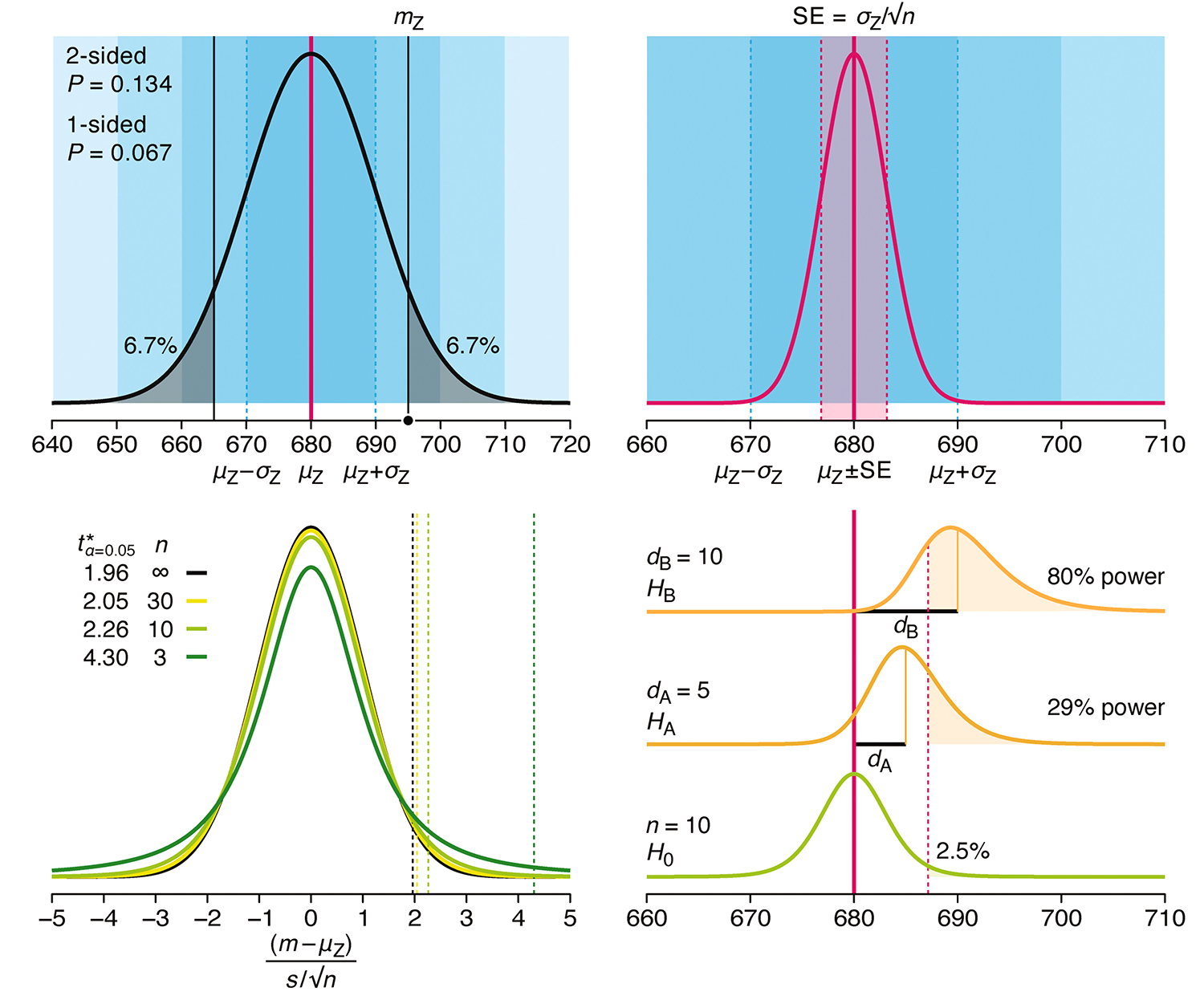
Altman, N. & Krzywinski, M. (2024) Understanding p-values and significance. Laboratory Animals 58:443–446.
